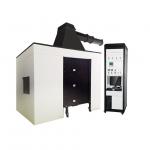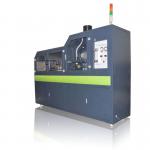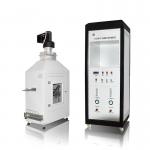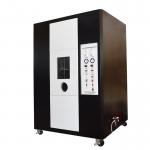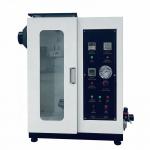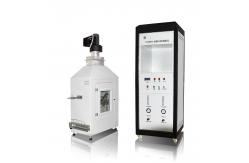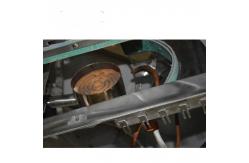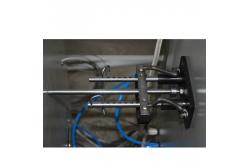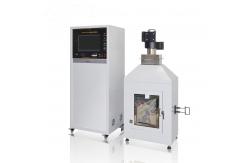In the field of fire safety and materials testing, the NFP92
Epiradiator Thermal Radiation Flame Propagation Tester emerges as a
crucial instrument. It is specifically designed to evaluate the
flame propagation characteristics of materials when subjected to
thermal radiation, providing valuable insights into their fire
behavior. The NFP92 Epiradiator Thermal Radiation Flame Propagation Tester is
a specialized device used to determine how materials respond to
thermal radiation in terms of flame propagation. It is widely
utilized in research laboratories, building material testing
facilities, and industries dealing with fireproofing and safety
regulations. By exposing samples to a controlled thermal radiation
source and monitoring the ensuing flame spread, it measures
parameters such as flame spread rate, ignition time, and the extent
of burning. These measurements are essential for understanding the
fire hazard potential of materials, ensuring compliance with safety
standards, and guiding the development and improvement of
fire-resistant materials and products. - Robust and Heat-Resistant Construction
- The tester is constructed from high-quality heat-resistant alloys
and refractory materials. The radiation chamber is carefully
engineered to provide a uniform and stable thermal radiation field.
Its interior surfaces are designed to minimize heat absorption and
reflection, ensuring that the focus remains on the accurate
assessment of the material's response to radiation. The exterior
casing is built to protect the operator and the surrounding
environment from heat radiation and potential sparks.
- The thermal radiation source, typically an epiradiator, is a
precision component. It can be adjusted to emit a specific
intensity and spectrum of thermal radiation, replicating different
real-world fire scenarios. The fuel supply or power source for the
epiradiator is reliable and accurately controlled, ensuring a
consistent radiation output throughout the test.
- Precision Instrumentation and Measurement Capabilities
- Equipped with advanced optical sensors and a sophisticated data
acquisition system, the tester can accurately measure the flame
spread rate. These sensors have a high sensitivity and rapid
response time, allowing for precise tracking of the flame front as
it progresses across the sample. Temperature sensors are also
strategically placed to monitor the temperature changes on the
sample surface and within the chamber.
- The user interface is intuitive and user-friendly. Operators can
easily set test parameters such as radiation intensity, sample
size, and test duration. The data acquisition system records all
test data in real-time, including flame spread rate, temperature
profiles, and ignition time. It can generate detailed reports,
complete with graphs and charts, that vividly illustrate the flame
propagation characteristics of the tested material. The tester also
has built-in calibration functions to ensure the accuracy of the
measurements over time.
- Controlled Sample Exposure and Ventilation
- The sample holder of the NFP92 tester is adjustable and designed to
securely position the samples within the radiation chamber. It
ensures that the sample is exposed to the thermal radiation in a
consistent and reproducible manner, enhancing the accuracy of the
test results. The ventilation system of the tester is also
adjustable, allowing for the control of air flow. This is crucial
as air movement can significantly affect the flame propagation
behavior, and the ability to manipulate it provides more accurate
and relevant test results.
3. Technical parameters | Test chamber | Dimensions: L1243mm * W460mm * H1661mm, made of stainless steel
plate with high temperature electrostatic baking paint. Lower part
has a fixed opening 50 mm high. Upper part has a smoke exhaust
port. Wall of the box body has a 30 mm thick insulating and
non-flammable protective layer made of 1/8 of vermiculite concrete
(8 rubites, 1 vanadium cement). Has an exhaust passage with forced
suction and regulator, connected to the exhaust port of the test
chamber, and equipped with a transparent observation window. Adopts
stainless steel tubular air inlet device with a filtering device to
shield indoor pollution sources. | | Radiator | Epiradiator heat radiation device, rated power 500W, radiation
surface is a quartz disk with a diameter of 100 卤 5mm. Spiral
groove in the disk with 6 turns of resistance wire for heating. Has
a heat flux density of 3 W/cm虏 in a parallel plane of 30 mm from
the radiating surface and is as uniform as possible. | | Sample support frame | Rectangular U-shaped frame made of three angle irons with a
high-end open state. Welded with a fixed mark on the angle irons on
both sides to measure the length of the flame. Welded with two
clips for fixing the net on both sides when needed. Mounted on the
same bracket as the radiator. Plane is inclined at 45掳, and the low
end is 250 mm from the bottom of the test chamber. Radiator is
adjusted so that the radiant disk surface is parallel to the plane
of the sample support frame with a spacing of 30 mm. The center
line of the radiant disk is in a plane equidistant from the left
and right sides of the sample support frame, and the lower end of
the radiant disk is about 40 mm away from the lower end of the
sample. | | Guard net | Made of 3mm diameter steel wire, divided into two forms for
materials with insufficient rigidity and those with obvious creep
during the test. Placed on the sample support frame to ensure the
distance between the sample surface and the radiating surface of
the radiator meets the specified requirements. | | Fire-fighting device - Lower ignition device | Jet portion has a circular arc shape with a radius of 100 mm and an
effective length of 180 mm. | | Fire-fighting device - Upper igniter | Upper part is rectangular, effective length of the lance is 60mm,
inner diameter of the nozzle is 6mm, with small holes of diameter
0.6mm and hole spacing of 20mm. | | Gas | Butane or propane gas | | Length of the pilot fire | 15 mm | | Each pilot | Equipped with a valve with an accurate indicator to regulate the
flow of gas. Needle valve controls the upper and lower burner flame
heights and is equipped with a flame height gauge. At the rear of
the pilot, there are two fixed ignition tubes that can ignite the
jet. Regulating portion of the pilot device is placed outside the
test chamber to adjust the distance between the pilot and the
sample during the test. | | Temperature measuring device | Five thermocouples (nickel-chromium-nickel-aluminum-magnesium alloy
thermocouples) placed in the center of the test chamber exhaust
port and four diagonals, and five thermocouples are placed on the
horizontal line at the bottom of the tank. The temperature
difference between the airflow and the input end shows the
temperature difference value status in real time. | | Electric control cabinet dimension | L770 x W600 x H1810 mm | | Working power | AC220V, 50HZ |
- Accurate Flame Propagation Evaluation
- The primary function of the tester is to provide a detailed and
accurate assessment of the flame propagation of materials under
thermal radiation. By precisely measuring the flame spread rate, it
determines how quickly a fire can spread across a surface made from
the tested material when exposed to heat radiation. A lower flame
spread rate indicates a better resistance to flame propagation,
which is essential for applications where fire safety is a top
priority, such as in buildings, industrial facilities, and
transportation.
- The measurement of ignition time is also important. It reveals how
long a material can withstand the thermal radiation before
igniting, providing valuable information about its fire resistance.
Additionally, understanding the extent of burning helps in
evaluating the overall fire hazard potential of the material and
its ability to sustain a fire.
- Compliance with Safety Standards and Regulations
- The building and manufacturing industries are subject to strict
safety standards and regulations regarding fire resistance. The
NFP92 Epiradiator Thermal Radiation Flame Propagation Tester is a
reliable tool for ensuring compliance. It enables manufacturers and
testing laboratories to conduct tests in accordance with the NFP92
standard or other relevant international and national regulations.
By using this tester, they can prove that their materials meet the
necessary fire performance criteria, facilitating market access and
enhancing consumer confidence.
- Regulatory bodies rely on the accurate test results obtained from
this equipment to enforce safety regulations. It serves as a
dependable means for inspectors and certifying agencies to
determine the suitability of materials for use in different
applications and environments, ensuring that only those that meet
the required safety levels are approved.
- Research and Development Support
- In the field of materials science and engineering, the tester is an
invaluable asset. It allows researchers to study the flame
propagation behavior of new and innovative materials. For example,
in the development of fire-retardant coatings, composite materials,
or new building materials with enhanced fire resistance, the tester
can be used to evaluate the effectiveness of different formulations
and structures.
- By understanding how different factors influence the flame
propagation under thermal radiation, researchers can optimize the
design and composition of materials. This could involve the
addition of flame suppressants, the modification of material
microstructures, or the development of new manufacturing processes.
The detailed data provided by the test equipment serves as a
roadmap for driving innovation and improving the overall fire
safety of various industries.
- Stringent Manufacturing Process
- The NFP92 Epiradiator Thermal Radiation Flame Propagation Tester is
manufactured under strict quality control procedures. Each
component is carefully sourced and inspected for quality and
performance. The assembly process is carried out by highly trained
technicians in a clean and controlled environment, ensuring the
proper alignment and functionality of all parts.
- The calibration of the thermal radiation source, sensors, and
measurement systems is a critical and regular part of the
manufacturing process. It is performed using traceable reference
standards to guarantee the accuracy and reproducibility of the test
results. Rigorous quality audits and inspections are conducted at
various stages of production to maintain the highest level of
product quality.
- Quality Certification and Validation
Our tester has obtained relevant quality certifications and has
been validated by independent testing laboratories. It has been
proven to provide accurate and reliable test results, conforming to
the NFP92 standard and other relevant international and national
safety standards. We also continuously update and improve our
product based on the latest technological advancements and customer
feedback to ensure its long-term performance and compliance.
- Building Materials Industry
- A leading manufacturer of wall coverings used the NFP92 tester to
develop a new line of fire-resistant wallpapers. The test results
showed that the wallpapers had a significantly lower flame spread
rate and longer ignition time compared to their previous products.
This enabled them to market the wallpapers as a safer option for
interior decoration, meeting the increasing demand for fire-safe
building materials. The company experienced an increase in sales
and enhanced its reputation in the market.
- A producer of insulation materials utilized the tester to optimize
the fire performance of their products. By testing different
formulations and additives, they were able to improve the
resistance of the insulation to flame propagation under thermal
radiation. The resulting insulation materials were widely adopted
in commercial and residential buildings, contributing to enhanced
fire safety.
- Textile and Upholstery Sector
- A textile company used the NFP92 Epiradiator Thermal Radiation
Flame Propagation Tester to evaluate the fire resistance of their
fabrics. The data helped them develop a new line of flame-retardant
textiles for use in upholstery and clothing. These fabrics met the
strictest safety standards and were well-received by customers in
the hospitality and fashion industries.
- An upholstery manufacturer incorporated the test results into their
product design process. By selecting fabrics with low flame spread
rates and good thermal radiation resistance, they were able to
produce furniture that complied with fire safety regulations and
provided enhanced protection in case of a fire.
- Research Institutions
- A research institute focused on sustainable materials used the
tester to study the flame propagation behavior of bio-based
polymers. The data obtained helped them understand the limitations
and potential improvements of these materials. They were able to
develop new bio-based polymers with reduced flame spread and
improved fire resistance, contributing to the advancement of
sustainable and fire-safe material technologies.
- Another research institution used the equipment to investigate the
effect of surface treatments on the flame propagation of metals.
Their studies led to the discovery of new coating techniques that
could significantly enhance the fire resistance of metal surfaces,
opening up new possibilities for the use of metals in fire-prone
environments.
- Pre-Sales Technical Consultation
Our team of experts provides in-depth technical consultations to
help customers understand the capabilities and suitability of the
NFP92 Epiradiator Thermal Radiation Flame Propagation Tester for
their specific testing needs. We offer demonstrations and training
to familiarize customers with the operation and functionality of
the equipment before purchase. We also assist in selecting the
appropriate test methods and accessories based on the materials and
applications to be tested. - After-Sales Service and Maintenance
We offer comprehensive after-sales service, including on-site
installation and commissioning. Our technicians are available for
regular maintenance, calibration, and emergency repairs. We provide
spare parts and upgrades to keep the tester operating at peak
performance. We also offer service contracts that include
preventive maintenance and priority technical support, ensuring the
long-term reliability and availability of the equipment.
|
